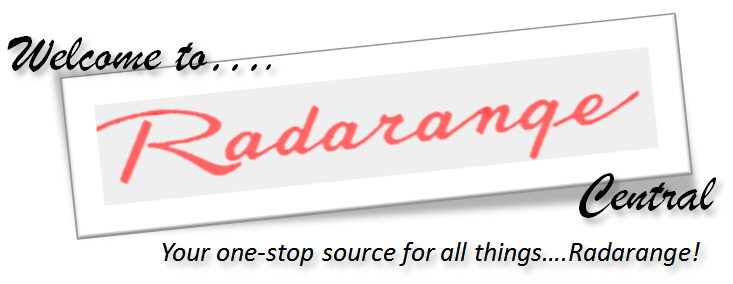
 |
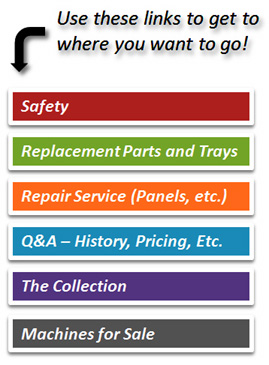 |
When I started this page all those years ago to chronicle the collecting of the RR series, I had no idea such a cult following would ensue. Soon, emails poured in from all over the US, and even a few international messages. “We love our Amana!,” “Where can I find part X,Y,Z,” “What year is my machine?” and “Can you fix mine?”.
Dripping with chrome, exuding class, style, and workmanship, the Amana Radarange was the first popular home microwave oven. Introduced in 1967, it set the bar for the competition for years to come. |
|
Q&A |
|
|
Safety |
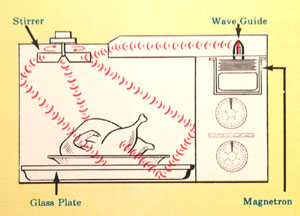 |
|
The Collection Next came the Cookmatic series, which essentially cycled the magnetron electronically and allowed the user to set the percentage of time for a given cycle the magnetron was powered via a slide control. Touchmatic debuted with the RR-6 which allowed digital time entry, and for many, was the first microprocessor in the home. The temp probe, programmable cooking and digital Cookmatic levels were to come. By the early 80's, cheap imported models were flooding the market and tastes were changing style-wise. As a follow-up to the "all-chrome" Touchmatic (9TA) and Touchmatic II (10A), a parallel series of RRL machines were introduced with smoked-plexi fronts, square corners and subdued brightwork. Internally, they're identical to the RR series and were built just as well. Each of these has a counterpart to the old series; for example, the RRL-7C is the analog model, the RRL-10 is the Touchmatic 2, and so on. Whether it was to use up parts, or simply an homage to the original design, the RR-8T was introduced with a plastic keypad and VFD readout but in the old cabinet to replace the 9TA, and the 10A continued to be produced as the RRH-10 "Heritage" model with matching nameplate under the controls, also all in the old style. In fact, the 8T control panel was used as a service part for years after to replace 9TA panels. Following these two parallel series was another home-run for Amana: the "hundred" series. These machines have the same dimensions as the original, and strike the perfect balance between too-much and too-little brightwork. Door handles are spring-loaded allowing opening of the door without needing to hit STOP to unlock the latch. Power supplies are simplified, and serviceability was made even easier. The RR-700 was the analog model, while the RR-900 became the new Touchmatic, and the 1000, the T2. These had plastic membrane keypads in a layout like the original 9T and 10. Mechanical buttons were retained for START, STOP and LIGHT. It didn't take long to revise the layout of the keypads for something a little sleeker, and the 900 and 1000 became the 910 and 1010. The 700 continued without change (and was extremely popular based on the number of survivors). The final update of these eliminated the mechanical pushbuttons, which is unfortunate given that membrane keypads eventually fail. These models end in '20', such as 820, 1020, etc. The higher the number, the more features. Finally, there's the RR-1220 Mastercook model which brought something new to the table- it actually cooked by weight! After 1985 it was pretty much all over as smaller models were introduced and assembly was moved offshore. But in the end, there are A LOT of different model numbers. |
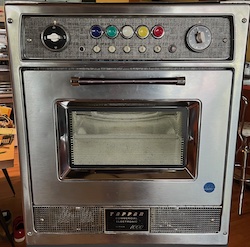 |
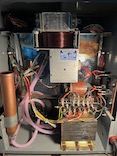 |
Tappan 1000 (restored) In 1955, Tappan was the first to break out of the commercial sector and offer a consumer model microwave oven, the RL-1, using Raytheon's licensed technology. It was expensive, required a 220V connection, used vacuum tube rectifiers and was built-in like traditional wall ovens of the time. You can find the same model with slight trim changes sold by Westinghouse, RCA-Whirlpool, and others. The Tappan 1000 at left is different. It's essentially a commercial version of the RL-1 and has an interesting story. Click Here for more pics and details. |
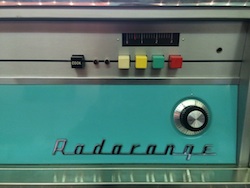 |
Raytheon Mark V. (restored) Prior to the purchase of Amana in 1965, Raytheon produced their own series of Radaranges for commercial and industrial use. Built with precision components, the design and assembly is on par with military electronics gear of the era (with a price to match). Through the 1950's and into the early 60's, Raytheon offered a series of 'Mark' models catering to restaurants and cafeterias. This rare 1963 Mark V features dual QK-707 magnetrons, a forced liquid cooling system with pump and radiator, and DC power via mercury rectifier tubes. The spring-loaded door slides vertically and a motorized stirrer distributes the waves from the magnetrons, which have their filaments lit even when idle. Specific cook-times can be assigned to the color-keyed pushbuttons, or you can use the timer. Click here for component view. |
|
 |
RR-1 (1967) The original home microwave oven. The RR-1 has an electromagnet for the magnetron and weighs in at 90lbs according to Amana service literature. These units have two buttons- START (green) and LIGHT (blue). The timers are additive so you can get 5 + 25 min total. Unlike all units after, the 5 minute dial is on the bottom, while the 25 min dial is on the top. The markings run opposite of standard timers and the dials only spin one direction, with a ratchet mechanism on the 25 min unit. RR-1's have a matte finish along the top and bottom horizontal recesses of the front. How does one stop the machine? By opening the door. |
|
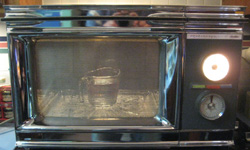 |
RR-2 (1968) Essentially an RR-1 with the addition of a STOP button, however if this is not to your liking you can still open the door to stop cooking. The lower timer has been bumped up to 30min and the sequential timing dropped. Upper and lower timers swap locations where they will stay through the 4D series. Timers can now be spun either direction and time increases CW. The perforated door screen continues to lack clear glass and plastic panels on either side, making splatter cleanup difficult but letting cooking aromas waft out. Early RR-2's lack an end of cycle buzzer, while later ones make it standard, and have a slide switch under the bottom lip of the control panel to disable it (as it will sound continuously until you hit Stop). If you don't find your RR-2 model tag on the back, check on the bottom (how convenient!). An RR5-2 has also been acquired which is the 240V/50Hz version with unique timer dials to accommodate the different line frequency. Click here to see the 50Hz and 60Hz 5 minute dials temporarily installed side by side. |
|
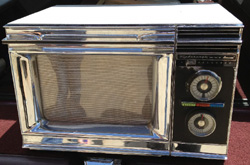 |
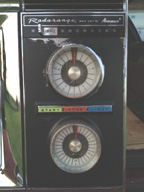 |
RR-3H (1971) While the early RR's had dual interlock door protection, a new government mandate effective for 1971 required that one of the interlocks be mechanical in operation. The 3H was introduced with a sliding LOCK lever at the top of the control panel to be compliant. The Start button will not physically engage unless this lever is locked. When unlocking, it automatically pops the Start button back out and stops the machine. From my research, the RR-3H was offered for less than one year until the introduction of the RR-4 late in '71 making it more difficult to find than an RR-2. Click HERE for the 3H Operating Instruction Page |
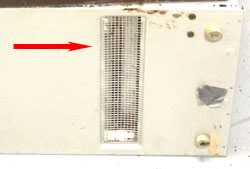 |
Did you know?
|
The early RR's have an air filter that should periodically be cleaned. These machines draw air through a vent in the bottom of the machine. Most of the time these filters have gone missing, but it never hurts to check. Be sure to pull your glass tray before you tilt the machine to avoid breakage. Clean filter with soapy water and air dry. |
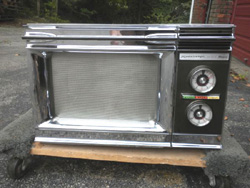 |
 |
RR-4 Introduced in late 1971, the 4 loses the LOCK slider and in its place is an electrically operated solenoid that prevents the door from opening during cooking. This solenoid was used up through the end of the traditional RR-series. The LIGHT button is no longer blue, but white. The green Start button gets a hue adjustment. The 4 still uses an electromagnet and a motorized stirrer. Panel background changes from black to dark brown and dial faces change yet again. 'Radarange' plate hides opening of the old Lock slider. |
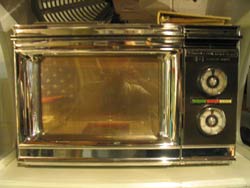 |
RR-4D (D for Auto Defrost) According to my records, the 4D was released in 1974, and the 4DW in '75. The defrost function of the 4D is very distinctive as the magnetron is cycled on/off at a 50/50 duty cycle. The 4D also has a permanent-magnet type magnetron which reduces weight and complexity. Early 4D's have a motor driven stirrer while later units are air-driven. RR-4DW Same as the 4D, except manufactured in Fayetteville, TN instead of Amana, IA. Note: The 4D & 4DW models must have proved very popular as there are quite a few of these still going strong in kitchens today. After August 7th 1974, the gov't mandated that the (already required) secondary interlocks disable the machine if they were to fail or were bypassed. The idea being that the machine would then remain out of service until an authorized tech could make the necessary repairs since gaining access to the power-electronics requires drilling out a rivet and breaking a warranty seal. |
|
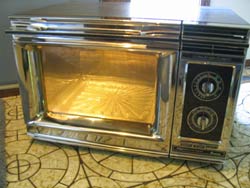 |
RR-5B* The successor to the 4D and later the 7D, this all-mechanical version features Defrost and Slo-Cook. Date of 1981. Includes end of cycle bell, but no COOK light. If someone were looking for a no-frills, dead-reliable machine, this would be it. RR references indicate a COOK light on Canadian 5Bs only, perhaps to satisfy Canadian regulations? In the early 80's, the RRL-5C would replace the 5B with the same features, but updated styling and a single mechanical button: Start. *This machine was made in 1981 and chronologically comes after the 9TA and 10A models. There was no 5 or 5A as it was introduced when the 'B' suffix machines were released. |
|
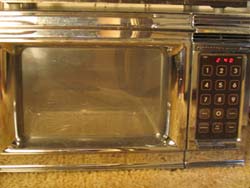 |
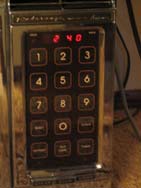 |
RR-6 / 6W First of the digital RR's. Lots of chrome, digital controls, and a neat egg timer function. Punch in your desired time interval, hit the Timer button and the display counts down to 0, followed by a pleasing electronic tone. Manufacture date of 1976. The 6 came out shortly after the 4D so you had your choice of analog or digital models. 'W' denotes Fayetteville, TN manufacture. |
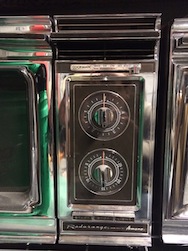 |
RR-7 Here's where it gets interesting. The RR-7 looks unassuming enough with its dual mechanical timers (just like the RR-4D it replaces), but on the inside it does for analog electronics what the RR-6 did for digital. In fact, it's the only RR I'm aware of with a thyristor control for the fan, lock and timers. A quad-comparator IC varies cooking power via the Cookmatic slider. And to power this module, 24V is obtained from a special winding on the power transformer. Circa 1976. Weight: 81 lbs. |
|
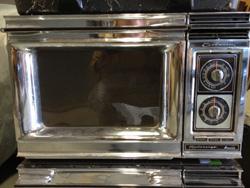 |
 |
RR-7B The 7B appears to be equivalent to a 7A Conversion. It features a 30 min. timer on top and Cookmatic Percent Timer on bottom (10%-100% on-time). Circa '82. The B signifies the third generation of this series so you had the 7, 7A and 7B. An indicator located in the area between the dials lights when the magnetron is powered on. |
 |
 |
RR-7D / 7DA Dated Jun 1979. This unit was introduced the same time as the 7 as an entry level machine. Instead of the sophisticated Cookmatic slider circuit, it uses a percent timer motor like the old RR-4D to provide Slo-Cook and Defrost. Note the clever timer that is specially geared to provide greater "resolution" for the first 5 minutes. I have found at least one later version that uses the more conventional linear timer used on all other mechanical models (see 5B). A small indicator between the dials lights when powered on. |
|
|
Did you know?
|
Introduction of the temp probe: If you grew up with a Radarange, you know that lurking somewhere in the kitchen junk drawer was the Amana temp probe. There's actually two different probes- those with brown cords are for cooking and are rated up to 190F. Probes with white cords (that were sold separate from the RR) are for candy-making where temps are 230F or higher. |
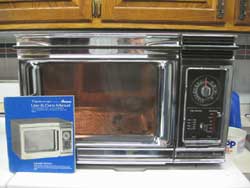 |
RR-8 / 8A A very feature-packed machine! Feb 1979, this RR features an electronic Cookmatic slide to control power from 10% to 100% like the 7, but adds temp probe capability with a front-lit setpoint control and needle indicator for measuring food temp and hold operation. When the probe is plugged in, the Temp Control scale illuminates and the pointer indicates current temp. Turn the dial to increase the red area behind the scale and the machine will run to meet that temp, then enters a cycling hold-mode. |
|
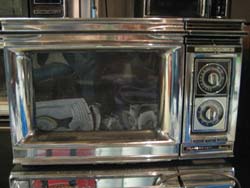 |
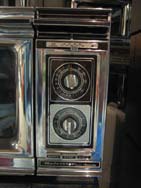 |
RR-8B Consider this a 7B with an electronic temp slider at the top with hold LED. When the temp probe is connected the timer's contacts are bypassed. Note the slider is for temperature, not power level like the original 7A. |
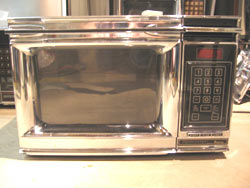 |
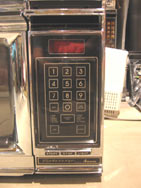 |
RR-8T I have a theory this model was introduced to use up existing parts. It has the functionality of an RR-9 but the touchpad has been cost reduced- it uses membrane switches rather than glass, and the LEDs have been replaced with a vac fluorescent display. This would continue with the 8TC and 8TD. There was also a 9TB released the same year with similar display and appearance. October 1981. |
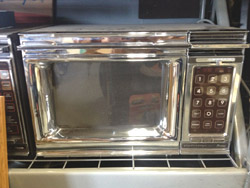 |
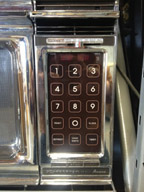 |
RR-9 Amana realized they could add the Cookmatic 'Powershift' feature to their 6 resulting in the RR-9. The 9T (below) improves on this concept by going completely digital and incorporating the temp probe feature. |
 |
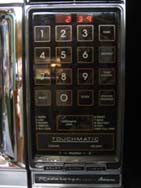 |
RR-9T This is the machine most people recognize instantly as a "Radarange". This landmark machine is the first to debut the Touchmatic name, incorporates both a digitally controlled Cookmatic Level, a digitally controlled temp probe and the capability to store two cooking programs. July 1978. |
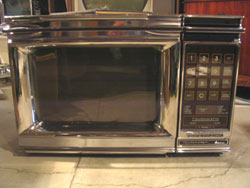 |
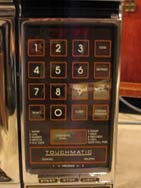 |
RR-9TA Between 1978 and 1981, a number of internal changes were made in the RR series including Cookmatics, mostly related to ease of assembly. The magnetron and power supply are still high quality. Machines with translucent splash shields are of the revised style while machines with solid-white splash shields are of the older design. 9TA's also have a cost reduced control panel (internally). And externally, the fill-in paint border of the 9T has been eliminated. The 9TA and 10A weigh in at 73 lbs. net. |
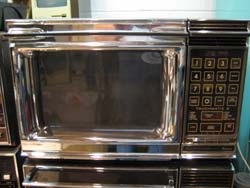 |
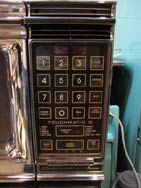 |
RR-10 The first Touchmatic II, manufacture dates show both the 10 and 9T were sold concurrently. The 10 adds two additional cooking programs for a total of four. There is also a programmable Start Time feature allowing one to set up cooking paramters and have the machine start cooking at an exact time up to 12 hours in advance. Sounds a little odd for a microwave, but with the temp probe, 4 programs and Cookmatic, one could defrost, slow-roast and temp-hold a ham over the course of an hour and have your meal ready as you walked in the door. This machine was manufactured Oct 1977. |
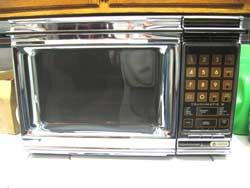 |
 |
RRH-10 Yes, that's the correct model number. Obviously the 'H' is for Heritage, but what's interesting is that this machine has a 10 "bordered" panel but 10A colored controls. It was also built in Dec 1978, yet the chrome door models continued to be offered for several more years. Internally, the RRH-10 is identical to the 10. |
 |
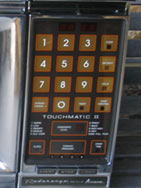 |
RR-10A The 10A features the same engineering changes as the 9TA (note the lack of painted border on the control panel). The button backgrounds are now an orangy-brown.The case is woodgrain vinyl. As with most Radaranges, there were multiple revisions (see numbers below). P74750-1M: Initial release. |
|
In the late 1970's, Amana was preparing to debut a new look for the Radarange line, still using the same tried-and-true technologies of the RR series. The first update was known as the RRL's, and were sold concurrently with the chrome door models. These are rectilinear in design without excess chrome or other adornments yet they are unmistakably Radaranges, right down to the three mechanical pushbuttons. Shortly after the chrome door models went out of production, a new line was introduced reviving the RR nomenclature. Perhaps the RRLs were already looking dated with their boxy, woodgrain aesthetics. The RR-700 and RR-900 shown below from 1985 were very popular and once again, introduced chrome details with a modern twist. They are easily identified by their spring-loaded door handles. Being half a decade newer than the RRL's, they take advantage of a lot of cost-reductions, but I should add, are very well engineered. These machines are the last to use the traditional RR glass trays. |
| Examples of RRL and "new RR" machines.... | ||
 |
 |
RRL-9TA This is the RRL series equivalent of the RR-9TA. It retains the solid steel and expert craftsmanship of the earlier models and also features the classic red LED look, but the door and controls are more in-line with late 70's early 80's styling. 73 lbs. net weight. |
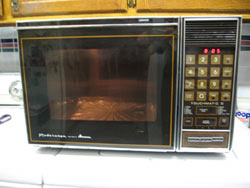 |
 |
RRL-10A This is the Touchmatic II version of the RRL line. Note the button background color that matches the RR-10A. The orange trim became more subdued on later RRL-10As along with the button borders. At least two different versions of this machine exist with different control panel circuitry (so parts could be shared with the RMC) but the SAME external appearance. Build date of January 1980. RRL-10C (not pictured) Has a revised vent appearance but is otherwise identical. A stopgap until the major design overhaul shown below. |
 |
Did you know? | Cooking time and Cookmatic power levels can be changed on the fly on the Touchmatic machines. Simply enter the new time and function (Cook, Defrost, etc.) while the oven is cooking and press Start. The RR won't miss a beat! |
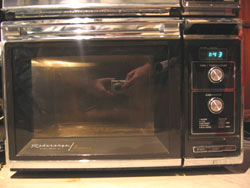 |
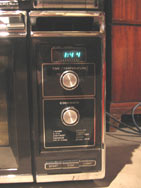 |
RR-700 A throwback to analog appearance with a digital flair. One knob is a rotary encoder for setting cooking time & temp, the other is a variable pot to vary the Cookmatic level (which shows as progressive bars along the bottom of the display). When turned fully CCW, setting the Cook time and pressing Start puts the machine in Timer mode. This model debuted for 1982. Hold in Start for 2 seconds to enter Clock Setting mode. Dial in time of day. Press Start again. RR-700 Built-In Click HERE to see the built-in version (Sep 1985). A factory plate blocks the front exhaust vent and notice how the door hinges on the side. Yet it's still marked RR-700. |
 |
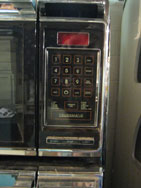 |
RR-900 Like the 700 above, you still have mechanical switches for Start/Stop/Light, but a dimmer vacuum fluorescent display and smaller "pushbuttons" that resemble the glass touchplates of old, but are actually membrane switches. Functionally, this is a basic Touchmatic with adjustable cooking power, much like the old RR-9T. Sep 1982. |
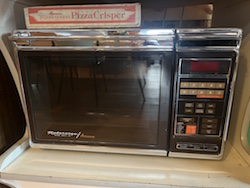 |
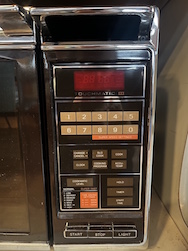 |
RR-1110 Touchmatic III: When the standard Radarange isn't powerful enough, you could step up to the Touchmatic 3. This unit features a higher power magnetron and requires a dedicted 20 amp circuit, but that limitation is likely why this model was a flop with consumers. Only a handful have popped up nationally in the last 20 years. |
|
It's the early 80's and the RRL series needs a facelift. The woodgrain gets pulled, the orange accents are out, and the control panel and door get a contemporary makeover (including vac fluorescent displays), though the fixed handle remains. Voila! A fresh look. The RRL-820 below from 1985 is a good example of this version. Meanwhile, it’s time for an update to the RR line which has had a good run. Amana decides to streamline things and debuts the RR-700, 800, 900 and 1000. You’ve got 4 models to choose from, each with increasing functionality, similar to the old days of the 7, 8, 9T and 10. The machines sport a new chrome trim panel with the familiar 3-button controls at the bottom and a door with a spring loaded handle that still complies with all regulations yet can be opened while cooking. The 800, 900 and 1000 are “Touchmatic” machines while the 700 offers analog dials with digital precision. Progressive updates to these models were introduced first with an updated keypad layout (810, 910, 1010, etc). Then elimination of the 3 mechanical switches, resulting in 820, 1020, etc. Things were pretty much done by '85, but two notable, and fairly rare machines were introduced in this period. The RR-1110 Touchmatic III which is a high powered residential unit with a special magnetron & power supply, requiring a 20A circuit. And the Cookmatic RR-1220 which has sensors under the glass tray and cooks by weight! Small, cheap microwaves then began to flood the market and the overly-built Radarange wasn't the only game in town. A new, smaller model having almost nothing in common with the old machines was introduced. These have no interior trays, lots of thin metal and cheap plastic, and get the 'two-rows of buttons' look to the keypad to match the larger machines. End of the line. |
| Family-Wide Facelift | ||
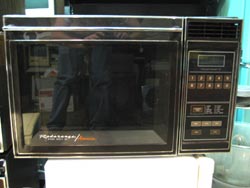 |
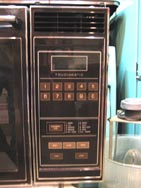 |
RRL-820 An example of the RRL-update. They don't get much simpler than this. One program. No temp probe. You get a digital keypad and a Cookmatic level. Note the revised control panel and lack of mechanical Start/Stop/Light switches. Manufactured Sep 1985. Additionally, RR-920 and RR-1020 machines were released the same year, each with additional features over the 820 but keeping with the new family appearance. |
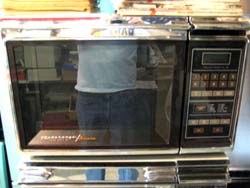 |
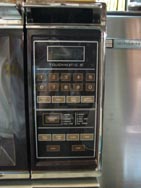 |
RR-1050 An example of the 'new-RR'-update but with features above the '20' series. As far as I know, no '30' or '40' series were ever produced. Again, no mechanical Start/Stop/Light switches and plastic controls. At least the 1050-level means you get 'Accutemp' and 'Accuthaw'. Aug 1985. |
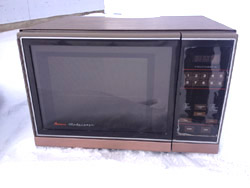 |
End of the Line... | RS415T And, for continuity, the smaller, less expensive model showing the double-row keypad. And yes, that's the model number. No longer US made. |
| Now that's different! | ||
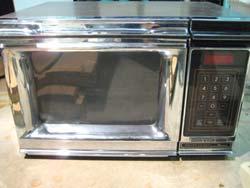 |
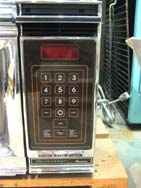 |
Replacement Panel - Based on build-date, this machine should have a red-LED 9T panel with glass touchplate, but instead has this cheaper plastic panel and vac fluorescent display very similar to the 8T above. Anecdotal evidence would suggest panels such as this were offered for service when originals became no longer available. |
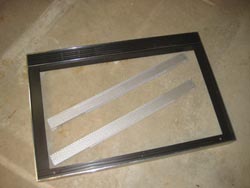 |
See Q&A Section
|
Built-In Kit - In the collection is both the UL approved galvanized wall sleeve and trimwork shown at left that allows any countertop model Radarange to be built-in to the wall and still allow proper air circulation. The ROs - Starting approximately 1979, Amana made a line of built-in-specific models with the RO prefix. All have integral galvanized sheetmetal housings to allow air circulation and have side-swinging doors hinged on the left. Air vents are along the top and bottom front of the unit. Shipping weight was 115 lbs. The RO-10A was the Touchmatic II version and the RO-24-8 was similar to the units used in the Amana 3+1 cooking centers, having a backlit analog timer, Cookmatic control and temp hold dial, all behind black glass. |
 |
See Q&A Section
|
Euro-Radaranges - While very rare, there were Radaranges made for the 220v 50Hz Euro market. This example is marked as an RR-5B though it appears to be similar to a US-made RR-9. Notice the ISO-centric control markings. Mechanical-timed RR's were also made for the EU market and used special 50Hz timer inserts while retaining 60Hz timers. |
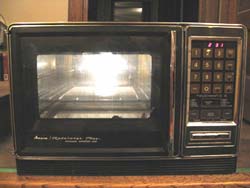 |
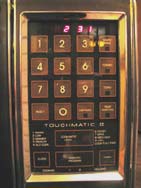 |
The RMC-Series - This RMC-30 was part of the Radarange Plus Series marketed in the late 70's/early 80's. It adds the functionality of a Touchmatic II microwave with the browning capability of a convection oven. The size is imposing, dwarfing a traditional Radarange, and it's got the weight to match. A 'Cookmatic' version with mechanical timer was also offered. Note the metal backing rack. There were also mechanical RMC-10 and RMC-20 versions. Late production uses a CRMC prefix. |
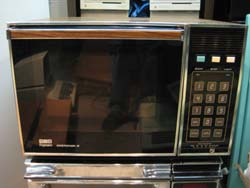 |
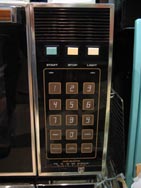 |
RCM-9 A Frigidaire microwave! Actually, it's an Amana Radarange in disguise, pretty much an RR-9 equivalent with the same heavy-duty power supply and Raytheon magnetron. Interestingly, it has a woodgrain cabinet. The rear dataplate appears similar in size and shape to the Amana yet lists Frigidaire as the manufacturer. The keypad font matches Frigidaire's line of Touch n' Cook digitally controlled appliances. Click HERE for the unique interior door text. Manufactured July '77. Note: Amana also had an agreement with Westinghouse and at least one Westy-badged version from the early 70's has surfaced. |
|
Pics to Come...
|
The R-Series - Occasionally, I get contacted about an R-1 or R-2 or R-x machine. Amana actually offered a lesser known series of Radaranges in parallel with the RR series starting in the very late 60's, and it's obvious why they failed to catch on. In an attempt to accomodate low hanging kitchen cabinets, the magnetron and power supply are placed at the rear of the unit making for an extremely deep cabinet with an awkwardly sized oven cavity. |
| Accessories | |
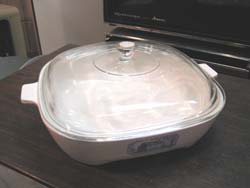 |
A number of Corning pieces were made for the Amana Radarange line, many incorporating internal RF-absorbing plates that convert microwave energy into thermally conducted energy that provides traditional searing, baking and crisping. Most include instructions to "pre-heat" the cookware in the microwave for several minutes before use. This is the MW-10 covered Browning Skillet which measures approximately 10x10x2. Corning also made similar dishes for Litton with a very 70's yellow/orange sunburst pattern though they're hard to find. Even tougher is the design for GE microwaves featuring a random 'sawtooth' electronic waveform pattern. |
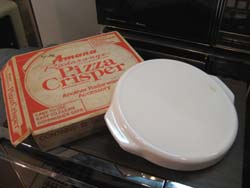 |
The 12" Pizza Crisper works on the same principal. While the cheese melts and the toppings cook, the crisper plate crisps the crust from below.- MW-12A. |
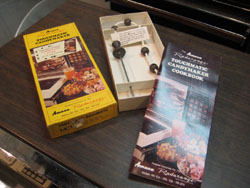 |
The MCT-1 Probe is for Candymaking with compatible Radaranges and was sold separately, though sometimes included with other accessories to 'make the sale' of a new Radarange. The temp range is significantly higher than the brown corded probe which tops out at 190F. |
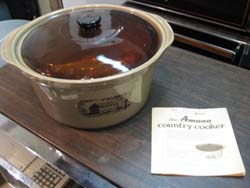 |
My hunch is that most Country Cookers saw primary duty outside of the microwave ovens they were designed for. Measuring 10-3/4 tall and approximately 4qt in volume, these covered stoneware vessels are also oven-compatible. They were made by both Western Stoneware and Cardinal Stoneware. |
 |
MWK-30 Cookit Grill. This 3 piece set is designed for cooking bacon, making burgers and grilling other meats. It consists of the MR-1 rack, MW-2 base and the Pyrex MW-2C lid. |
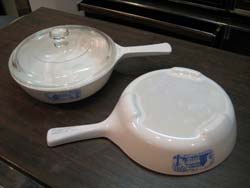 |
This is the small, round browning skillet offered by Amana. No model number imprinted on the handle. Approximately 6-3/4" diameter by 2" deep. |
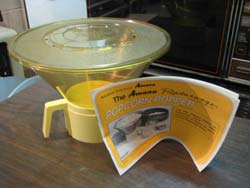 |
MWP-1 - Everyone's favorite cardboard flavored popcorn! The base concentrates RF energy for popping regular popcorn kernels without oil or butter; straight from the era of air-poppers. Since corn kernels have very little moisture content, popping any kind of popcorn in the microwave can be very hard on the magnetron. |
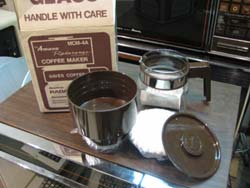 |
MCM-4A Coffee Maker - There was also a straight MCM-4. This one is new in the box and I'm not sure how inclined I am to indulge in the promise of microwave coffee. |
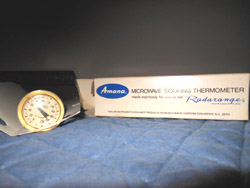 |
Made of polysulfone, an analog thermometer made by Taylor Instruments was also offered. Registering 0-220F on a 1-1/2" dial it is completely microwave safe and "fast acting". |
|
The introduction of a new way of cooking meant that all the traditional recipes in the card file were no longer applicable at mealtime. While not accessories, per se, several different cookbooks were released by Amana with tips, suggestions and recipes for getting the most out of your Radarange. These were often included as part of the sales package with your new machine. The book at left is copyright 1968 (circa the RR2 release) and includes inserts for operation of the 3H (1971). It has a three-ring-binder format. In 1972, Amana released the "New Microwave Oven Cooking Guide" to coincide with the RR-4 release. This is also a 3-ring-binder format though more professionally done. These two make up the early Amana cookbooks worth picking up. Publications after this were more traditional, though probably more useful as actual cookbooks. |
|
 |
And what better place to put those new microwave recipes than in the Radarange Recipe File. |
| Machines for Sale Every now and then I come across a duplicate machine that deserves a home. When that happens, and time willing, I’ll offer it in this section. These machines are cleaned, repaired, any worn parts replaced, the magnetron is performance checked and the whole machine gets an RF-leak test. Yeah, shipping is a killer. |
|
None at this time.
|
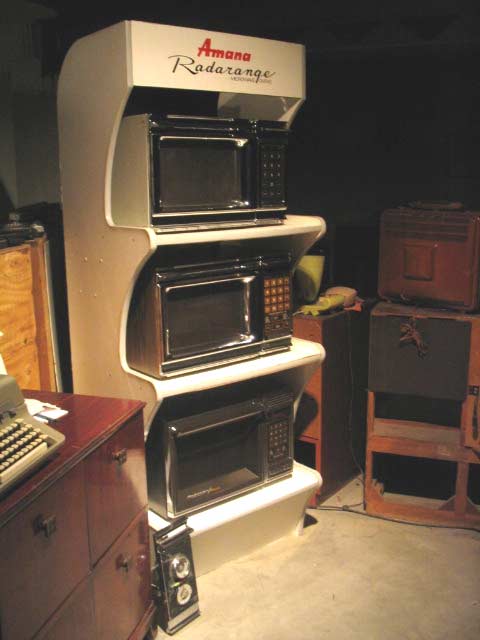
Last Updated Mar 2025
Cory Heisterkamp